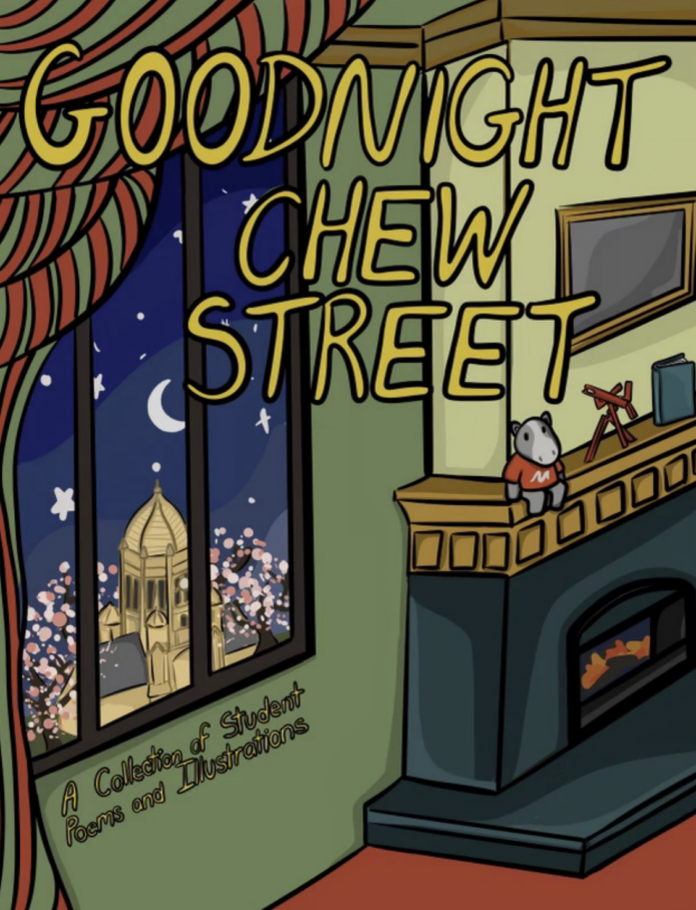At Muhlenberg College, the cultivation and well-being of the campus community as well as the abundance of innovation that lies within these red doors serve as the foundations for those individuals and their passions to thrive. The main objective behind a community such as Muhlenberg’s is to have its students practice and pursue what they care about, having support and a space to lean on. These elements are not simple, and in fact, must be intentional to achieve the best outcomes in purposefully bringing people together. This vision is one that students last semester attracted the dedication and care of in the tedious and involved development of a book that reinforces these core values. As a beautiful result, “Goodnight Chew Street” came to fruition.
This book is student-crafted and based on the classic childhood storybook, “Goodnight Moon” by Margaret Wise Brown. “Goodnight Chew Street” is composed of unique illustrations and poems inspired by the many specialized campus departments. These poems bring departments to life and highlight the connections between many areas around campus, giving an ode of acknowledgment and spreading love about what they serve. Maddie Davidson ‘25, student coordinator and writer, and Harry Glickin ‘26, who served as a copy editor, layout editor and writer, provided interesting, yet highly introspective insight, regarding the work behind “Goodnight Chew Street.”
“…what do you love about your space? What do YOU love?” – Maddie Davidson ’25
“I’d have to say the biggest focus on making it was the area of collaboration” Glicklin states as he recounts his experience on the creative team. It became crystal clear the significance of the book’s meaning and message wasn’t through its physical result alone, but more importantly its collaborative process, spanning over the entire student body. The production process flourished from engaging with other people to collectively make something special. Davidson began by sending out emails, department by department, office by office, and meeting representatives and affiliated students. Networking with interested writers and artists to contribute, they then individually scheduled meetings with department representatives and affiliates. The aim of these meetings was to explore the purpose and heart behind each department’s significance to students and Muhlenberg. From those connections and discussions fortifying an outlet for those departments, the poetry and illustrations spoke for themselves. Glicklin had written a poem in tribute to the President’s Office, with Alex McCauley ‘26 as illustrator. The words represent elements within its space that people who take notice gain an appreciation for. He mentions the candy dish, the big windows, the “Little Henry” statue and other frames of reference. The illustration is a detailed rough sketch of one of the windows, trees dancing through the gusts of wind outside. These pieces paint a scene and recognize what students come to know and enjoy within these separate departments, yet still bring us together. This process was very successful and effective, as it reflects the sole point of the book through its development from the ground up.
As Davidson pointed out her set of priorities in correlation to her vision, she mentioned concepts of “sustaining community” and creating opportunities for connection and interaction that have flourished throughout the project. She emphasizes the intrinsic value of social connection provoking self-reflection: “… it inspires the question, what do you love about your space? What do YOU love?” She strived to reaffirm the power of words and to “humanize” the Writing Center, the place where it all began. She states, “The people here at the Writing Center hold broader, greater values beyond helping you with your paper,” and she reflects that many of the surrounding departments at Muhlenberg do the same.
“The people here at the Writing Center hold broader, greater values beyond helping you with your paper.” – Maddie Davidson ’25
Davidson considers the pursuit of this book to give these departments, some sadly underappreciated or underrepresented, “a voice and a vessel” to strike a new level of gratitude. Diving deeper into the truer sense of how community serves us all, the purpose of the departments and individuals within them can be made personal, affecting students in unforeseen ways. Regardless, they are worth celebrating and sharing.
To further the incentive of caring for the community and advocating for those in need, the money raised out of profit will be donated to the Student Relief Fund, providing students pursuing secondary education with a lack of financial support aid. “Goodnight Chew Street” will be available for purchase in the ‘Berg Outfitters shop and at a discounted price sold at a monthly tabling near the Writing Center.






















